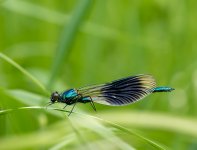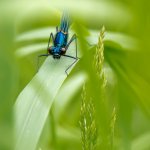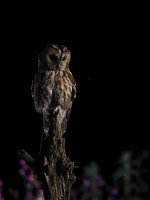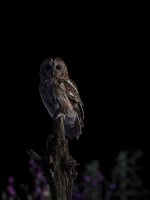ISO in excess of 800 does not seem to be excessive, depending on what camera you have. I have used iso 6400 with no problem after using denoising software(on1) and obtained good results. Pershaps a phone call to discuss options would help but keep your options open and have the tc handy if you are not using it. sorry for the ambiguous response but enjoy and hope whatever you decide works well!Very good and valid perspective.
If a bit more environment in the VF and images.......a crop may not be a frame filler but as you point out the slightly wider FoV can be and is beneficial
As I understand the hide advice for this species 400mm is the sweet spot and 300mm mFT is 600mm full frame equivalent......that will too long.
In regard to ISO, in Comms is likely to be in excess of 800!
In summary, the bare 40-150mm f2.8 looks like the most appropriate option........though keeping the x1.4 TC to hand should the situation indicate it's possible usage.
You are using an out of date browser. It may not display this or other websites correctly.
You should upgrade or use an alternative browser.
You should upgrade or use an alternative browser.
Olympus OM-D E-M5, E-M1, E-M10 - Mk1, Mk2 & Mk3 Owners Thread
- Thread starter bl0at3r
- Start date
- Messages
- 15,825
- Edit My Images
- No
The OM-1ISO in excess of 800 does not seem to be excessive, depending on what camera you have. I have used iso 6400 with no problem after using denoising software(on1) and obtained good results. Pershaps a phone call to discuss options would help but keep your options open and have the tc handy if you are not using it. sorry for the ambiguous response but enjoy and hope whatever you decide works well!
In general I am not fussed by noise as DxO PhotoLab handles it so well.
However, a dark bird in mixed light with as I perceive it darker backgrounds there is a potential for more shadows than some 'scenes' where noise could be a factor. Noise (too much???) in the shadows is not welcome.
I will watch my histogram and see how it goes
Had more macro attempts with the 1.4 on the 90mm this evening. Used a gorilla pod and took 15 shot stacks. Put together in Helicon. Its not perfect but considering this fly is about 0.5cm long and it was in natural evening light I am really impressed by the combo and how its opened up another area of wildlife photography i've never been able to dabble in before.
 Fly by Pete, on Flickr
Fly by Pete, on Flickr
 Fly by Pete, on Flickr
Fly by Pete, on Flickr- Messages
- 11,823
- Name
- Jeremy Moore
- Edit My Images
- No
Just wondering if anyone regularly uses the Hi-res mode on the OM1 and if so what their impressions / experiences were like.......
I am so happy with the om-1 and 90mm macro. Ive taken photos of this extremely rare moth (pyrausta sanguinalis) for years with all sorts of equipment but being able to do in body focus stacking handheld has meant I can now get photos of it I have always dreamed of.
Its about 7mm long and this was a 15 shot in body stack handheld in natural light.
 Pyrausta Sanguinalis by Pete, on Flickr
Pyrausta Sanguinalis by Pete, on Flickr
Its about 7mm long and this was a 15 shot in body stack handheld in natural light.
 Pyrausta Sanguinalis by Pete, on Flickr
Pyrausta Sanguinalis by Pete, on Flickr- Messages
- 15,825
- Edit My Images
- No
@Bebop @GyRob
By way of thinking out loud........
I have looked in the manual to remind me about the way the DTC (Digital Tele-converter) behaves......I have never used DTC and never seen its potential benefit, so far.......summarised below as I read & understand it.
Stills the DTC applies a x2 enlargement/crop
When shooting raw in the EVF & LCD the image is cropped but the raw is unaffected i.e. a bit like changing the aspect ratio (I do have mine set to 3:2) the full sensor image is saved (NB only if shooting JPEG is the saved file, the zoomed in/cropped area)
The turning on/off of DTC can be button assigned.
Therefore my thinking is:-
That I assign the L-Fn button to control the DTC
I can then see in the EVF & LCD (maybe using the LCD more the EVF and a remote release cable) the effect of a x2 crop but knowing I will have the unadulterated raw file to crop as needed in post
If I have understood the DTC and its use, especially when shooting raw, are there any downsides.......bearing in mind, as I have found myself provided the crop is not too huge the file can be printed quite large following PP) Plus as said by @nc_killie says NR as needed is very good
I would welcome any further insights about the use of the DTC
PS just a pity the DTC cannot do x1.4 for stills like the video mode
By way of thinking out loud........
I have looked in the manual to remind me about the way the DTC (Digital Tele-converter) behaves......I have never used DTC and never seen its potential benefit, so far.......summarised below as I read & understand it.
Stills the DTC applies a x2 enlargement/crop
When shooting raw in the EVF & LCD the image is cropped but the raw is unaffected i.e. a bit like changing the aspect ratio (I do have mine set to 3:2) the full sensor image is saved (NB only if shooting JPEG is the saved file, the zoomed in/cropped area)
The turning on/off of DTC can be button assigned.
Therefore my thinking is:-
That I assign the L-Fn button to control the DTC
I can then see in the EVF & LCD (maybe using the LCD more the EVF and a remote release cable) the effect of a x2 crop but knowing I will have the unadulterated raw file to crop as needed in post
If I have understood the DTC and its use, especially when shooting raw, are there any downsides.......bearing in mind, as I have found myself provided the crop is not too huge the file can be printed quite large following PP) Plus as said by @nc_killie says NR as needed is very good
I would welcome any further insights about the use of the DTC
PS just a pity the DTC cannot do x1.4 for stills like the video mode
- Messages
- 145
- Name
- Adrian
- Edit My Images
- No
I am so happy with the om-1 and 90mm macro. Ive taken photos of this extremely rare moth (pyrausta sanguinalis) for years with all sorts of equipment but being able to do in body focus stacking handheld has meant I can now get photos of it I have always dreamed of.
Its about 7mm long and this was a 15 shot in body stack handheld in natural light.
Pyrausta Sanguinalis by Pete, on Flickr
A stunning shot of a beautiful and rare moth, I take it you are based in the Isle of Man to have taken this. The last record for this species near me (Shropshire) was way back in 1952. I've the same combination of camera and lens and am becomming more and more impressed by its capabilities and the quality of the images it enables me to obtain.
Last edited:
Ty. Yes based in the Isle of Man. My next target will be Heath bee fly next month. I had no idea that’s only found here and Dorset.A stunning shot of a beautiful and rare moth, I take it you are based in the Isle of Man to have taken this. The last record for this species near me (Shropshire) was way back in 1952. I've the same combination of camera and lens and am becomming more and more impressed by its capabilities and the quality of the images it enables me to obtain.
- Messages
- 2,066
- Name
- Robert
- Edit My Images
- Yes
When i used Olympus I never used DTC - to be honest i always shoot in Manual with any camera and only set a button or 2 just to change something quickly .
The menu in all cameras are so vast in what you can do and set and that's great but not for me jpeg fine /fps / and a little colour profile is about all i touch .
I use Sony now and use it the same .
Rob.
The menu in all cameras are so vast in what you can do and set and that's great but not for me jpeg fine /fps / and a little colour profile is about all i touch .
I use Sony now and use it the same .
Rob.
Ive never used it and I wouldnt to be honest. If I need to crop in I would do that all in post process so I have the control of how much to crop in.@Bebop @GyRob
By way of thinking out loud........
I have looked in the manual to remind me about the way the DTC (Digital Tele-converter) behaves......I have never used DTC and never seen its potential benefit, so far.......summarised below as I read & understand it.
Stills the DTC applies a x2 enlargement/crop
When shooting raw in the EVF & LCD the image is cropped but the raw is unaffected i.e. a bit like changing the aspect ratio (I do have mine set to 3:2) the full sensor image is saved (NB only if shooting JPEG is the saved file, the zoomed in/cropped area)
The turning on/off of DTC can be button assigned.
Therefore my thinking is:-
That I assign the L-Fn button to control the DTC
I can then see in the EVF & LCD (maybe using the LCD more the EVF and a remote release cable) the effect of a x2 crop but knowing I will have the unadulterated raw file to crop as needed in post
If I have understood the DTC and its use, especially when shooting raw, are there any downsides.......bearing in mind, as I have found myself provided the crop is not too huge the file can be printed quite large following PP) Plus as said by @nc_killie says NR as needed is very good
I would welcome any further insights about the use of the DTC
PS just a pity the DTC cannot do x1.4 for stills like the video mode
Its useful in video mode but the drop in image quality isn't as obvious in video.
Stephen L
I asked a Stupid Question Once...
- Messages
- 6,676
- Name
- Stephen
- Edit My Images
- No
That's beautifulI am so happy with the om-1 and 90mm macro. Ive taken photos of this extremely rare moth (pyrausta sanguinalis) for years with all sorts of equipment but being able to do in body focus stacking handheld has meant I can now get photos of it I have always dreamed of.
Its about 7mm long and this was a 15 shot in body stack handheld in natural light.
Pyrausta Sanguinalis by Pete, on Flickr
Stephen L
I asked a Stupid Question Once...
- Messages
- 6,676
- Name
- Stephen
- Edit My Images
- No
Not exactly an Olympus E series, but this was taken in 2001 on Staffa with an Olympus C2020Z. Uncropped, reprocessed in Lightroom.
 Puffins on Staffa by Stephen Lee, on Flickr
Puffins on Staffa by Stephen Lee, on Flickr
 Puffins on Staffa by Stephen Lee, on Flickr
Puffins on Staffa by Stephen Lee, on Flickr- Messages
- 15,825
- Edit My Images
- No
When i used Olympus I never used DTC - to be honest i always shoot in Manual with any camera and only set a button or 2 just to change something quickly .
The menu in all cameras are so vast in what you can do and set and that's great but not for me jpeg fine /fps / and a little colour profile is about all i touch .
I use Sony now and use it the same .
Rob.
As mentioned, in my perception of its use is purely(?) for framing/cropping insight.Ive never used it and I wouldnt to be honest. If I need to crop in I would do that all in post process so I have the control of how much to crop in.
Its useful in video mode but the drop in image quality isn't as obvious in video.
Having said that I did find this linked Thomas Stirr's webpage about DTC usage by Andy Rouse

Digital Teleconverter Test Images - Small Sensor Photography by Thomas Stirr
This article shares a selection of digital teleconverter test images that were captured handheld today at 40 Mile Creek in Grimsby.
smallsensorphotography.com
I know Andy Rouse can be a bit marmite and frankly him recommending DTC so strongly IMO is poor.
Why do I say poor, well it obviously suits him for good light and time pressure to get images to publishers quickly......he barely mentions the key benefit of shooting raw in reduced light conditions. And as in his own admission he is a dinosaur when it comes to relying on Photoshop! He IIRC says that cropping the raw and PPing to match the jpeg is too much trouble so is Adobe Camera Raw in the top class of .orf converters.... IMO not.
Edit ~ I have now watched the whole video and he does, somewhat, expand on his approach/advice.
PS having said that I may set raw + jpeg LS to just see what they look like.
Last edited:
Very pleased to find these today. Only my second time seeing Thrift Clearwing. A very tricky moth to photography in natural light with how the scales reflect.
 Thrift Clearwing by Pete, on Flickr
Thrift Clearwing by Pete, on Flickr
 Thrift Clearwing by Pete, on Flickr
Thrift Clearwing by Pete, on Flickr- Messages
- 7,134
- Edit My Images
- No
Sorry for delay, I’ve been away for the weekend. I have never used the DTC and hadn’t realised it leaves the raw unaffected.@Bebop @GyRob
By way of thinking out loud........
I have looked in the manual to remind me about the way the DTC (Digital Tele-converter) behaves......I have never used DTC and never seen its potential benefit, so far.......summarised below as I read & understand it.
Stills the DTC applies a x2 enlargement/crop
When shooting raw in the EVF & LCD the image is cropped but the raw is unaffected i.e. a bit like changing the aspect ratio (I do have mine set to 3:2) the full sensor image is saved (NB only if shooting JPEG is the saved file, the zoomed in/cropped area)
The turning on/off of DTC can be button assigned.
Therefore my thinking is:-
That I assign the L-Fn button to control the DTC
I can then see in the EVF & LCD (maybe using the LCD more the EVF and a remote release cable) the effect of a x2 crop but knowing I will have the unadulterated raw file to crop as needed in post
If I have understood the DTC and its use, especially when shooting raw, are there any downsides.......bearing in mind, as I have found myself provided the crop is not too huge the file can be printed quite large following PP) Plus as said by @nc_killie says NR as needed is very good
I would welcome any further insights about the use of the DTC
PS just a pity the DTC cannot do x1.4 for stills like the video mode
The only downside I can see is that a wider field of view is easier to get a bird in flight, so it may be harder to track a bird with it activated.
I can’t really see an upside other than getting your composition better in camera. What am I missing?
edit: just read your follow on post. Will watch the video later, but agree with your thoughts re effort to crop in post etc.
Last edited:
- Messages
- 7,134
- Edit My Images
- No
You are getting some stunning results with this combo. Fabulous imagesVery pleased to find these today. Only my second time seeing Thrift Clearwing. A very tricky moth to photography in natural light with how the scales reflect.
Thrift Clearwing by Pete, on Flickr
Are you stacking them in post or in camera?
- Messages
- 8,553
- Name
- Trevor
- Edit My Images
- No
OM-1 snaps
1
 Triumph TR3 by Trevor, on Flickr
Triumph TR3 by Trevor, on Flickr
2
 A faded Icon by Trevor, on Flickr
A faded Icon by Trevor, on Flickr
3
 Tanner Trio by Trevor, on Flickr
Tanner Trio by Trevor, on Flickr
1
 Triumph TR3 by Trevor, on Flickr
Triumph TR3 by Trevor, on Flickr2
 A faded Icon by Trevor, on Flickr
A faded Icon by Trevor, on Flickr3
 Tanner Trio by Trevor, on Flickr
Tanner Trio by Trevor, on Flickrthanks. I shoot all different depending on what the insect is doing (ie moving or even its antenna moving or something).You are getting some stunning results with this combo. Fabulous images
Are you stacking them in post or in camera?
The clearwing was just 1 shot as it rarely stayed still long enough.
For stacking my thinking is use in body method, if it works great. If it doesn't try and use the sequence of photos taken and use helicon because then I can do a lot of fine tuning to try and get a result but I wont do all that effort if the camera in body has gotten something good enough in the first place.
If its a stacked shot Ill say in my post. (and whether its helicon in post or in body).
- Messages
- 7,134
- Edit My Images
- No
Thanks. I’m about to help a friend out with some more focus stacked images for a scientific paper. We had a session ages ago and I’m just trying to think of best practices for next time. I wonder how Helicon stacks up (thanks. I shoot all different depending on what the insect is doing (ie moving or even its antenna moving or something).
The clearwing was just 1 shot as it rarely stayed still long enough.
For stacking my thinking is use in body method, if it works great. If it doesn't try and use the sequence of photos taken and use helicon because then I can do a lot of fine tuning to try and get a result but I wont do all that effort if the camera in body has gotten something good enough in the first place.
If its a stacked shot Ill say in my post. (and whether its helicon in post or in body).
- Messages
- 15,442
- Name
- Jeff
- Edit My Images
- No
- Messages
- 15,442
- Name
- Jeff
- Edit My Images
- No
Last edited:
Yes defo get the trial. I didnt realise about retouching for a while as well. That is such a useful tool for when the rendering has not gone perfectly.Thanks. I’m about to help a friend out with some more focus stacked images for a scientific paper. We had a session ages ago and I’m just trying to think of best practices for next time. I wonder how Helicon stacks up () against Affinity Photo 2. Last time I ended up manually choosing my focus points and then stacking in post. I might download a trial.
Cracker and what an insect that is!
One of the reasons to get the 300mm f4 was to hopefully have better chances with Dragonflies in flight. (Even though the 100-400 got me ones I was very happy with). But sure enough the 300mm can do even better, helping me catch species in flight I couldn't get good ones of before. (Common Blue Damselfly and Four-spotted chaser)
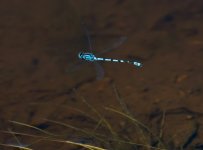 last year.
last year.
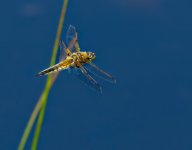
 last year.
last year.
- Messages
- 15,442
- Name
- Jeff
- Edit My Images
- No
Super Pete went looking for some yesterday and drew a blank .. weird year..
cameras all packed away now ,off to bempton cliffs on thurs for 10 days
cameras all packed away now ,off to bempton cliffs on thurs for 10 days
Last edited:
- Messages
- 15,825
- Edit My Images
- No
Safe journey and hopefully a great time......Super Pete went looking for some yesterday and drew a blank .. weird year..
cameras all packed away now ,off to bempton cliffs on thurs for 10 days
I look forward to seeing your posts
- Messages
- 11,823
- Name
- Jeremy Moore
- Edit My Images
- No
- Messages
- 837
- Name
- James
- Edit My Images
- Yes
Excellent work.A macro lens and use stacking isn't necessary to get sharp side-on photos of resting damselflies ..... this was taken with the 12-100 zoom on the OM1.
View attachment 390992
And sharpness isn't everything.......
View attachment 390993
- Messages
- 15,442
- Name
- Jeff
- Edit My Images
- No
Indeed most Olympus lenses are extremely versatileA macro lens and use stacking isn't necessary to get sharp side-on photos of resting damselflies ..... this was taken with the 12-100 zoom on the OM1.
View attachment 390992
And sharpness isn't everything.......
View attachment 390993
Apparently its very good for portraitsGetting tempted by the 90mm macro...
Order now or wait? (It doesn't appear to be in stock anywhere in the UK though.)
Versatility beyond its use for macro?
- Messages
- 15,442
- Name
- Jeff
- Edit My Images
- No
- Messages
- 15,825
- Edit My Images
- No
Update about the Tawny Owl session
No photos to share yet as did not get home until 11:30pm
The Tawny Owl session was a real joy, a beautiful bird.
As for settings, well it was a learning curve.......
The guy who owns the setup is a published photographer who now concentrates on videography of wildlife.
The owl does not appear until after sunset and last night came to visit 4 times. So the light was getting progressively worse(?).
With his guidance...I had never used this specific methodology before:-
Full manual ( 1/320 , f2.8 , starting iso for establishing the setup 3200). Focus & spot metering on the perch, NB AF once on the perch and then AF turned off.....gimbal locked off. Cannot recall now but think I was @ 6400 for her first visit.
By about 10:10pm the owl made its last visit and ISO, raising a stop @ time (test shot to 'check' the light on the perch), was 10,000 !
Other than above settings....wired remote used....and to avoid light from the rear screen it was closed off.....as the bird approached the perch it was press the shutter = goodly amount of culling to be done where not in frame & oof.
Oh, I used standard silent sequential not SH2 (I was unsure whether SH2 would affect the metering and no time to be testing.
Should I go again and I might but next year? I would add ProCap SH1 into the session....
I have only looked at them in the camera but many look very good. Once on PC and cull I will pp a couple and post to show the results
No photos to share yet as did not get home until 11:30pm
The Tawny Owl session was a real joy, a beautiful bird.
As for settings, well it was a learning curve.......
The guy who owns the setup is a published photographer who now concentrates on videography of wildlife.
The owl does not appear until after sunset and last night came to visit 4 times. So the light was getting progressively worse(?).
With his guidance...I had never used this specific methodology before:-
Full manual ( 1/320 , f2.8 , starting iso for establishing the setup 3200). Focus & spot metering on the perch, NB AF once on the perch and then AF turned off.....gimbal locked off. Cannot recall now but think I was @ 6400 for her first visit.
By about 10:10pm the owl made its last visit and ISO, raising a stop @ time (test shot to 'check' the light on the perch), was 10,000 !
Other than above settings....wired remote used....and to avoid light from the rear screen it was closed off.....as the bird approached the perch it was press the shutter = goodly amount of culling to be done where not in frame & oof.
Oh, I used standard silent sequential not SH2 (I was unsure whether SH2 would affect the metering and no time to be testing.
Should I go again and I might but next year? I would add ProCap SH1 into the session....
I have only looked at them in the camera but many look very good. Once on PC and cull I will pp a couple and post to show the results
- Messages
- 15,825
- Edit My Images
- No
Stephen L
I asked a Stupid Question Once...
- Messages
- 6,676
- Name
- Stephen
- Edit My Images
- No
Stunning and atmosphericOK a couple of quick runs at two that pleased me.
The one looking down is ISO10000 the other ISO 8000
DxO Elite PrimeXD NR
Cropped and finalised in PS
View attachment 391222
View attachment 391223
- Messages
- 7,134
- Edit My Images
- No
Those are fabulous! What a joy! Thanks for sharing the set Up.OK a couple of quick runs at two that pleased me.
The one looking down is ISO10000 the other ISO 8000
DxO Elite PrimeXD NR
Cropped and finalised in PS
View attachment 391222
View attachment 391223
- Messages
- 15,825
- Edit My Images
- No
Thanks and noiseless in flight tooStunning and atmospheric
Thank you. As with all wildlife it was a privilege to be in the presence of that wonderful wild owl.Those are fabulous! What a joy! Thanks for sharing the set Up.
The chap is very knowledgeable about its behaviour so helped immensely to have had the opportunity.
Just need to save/put aside the funds to go again somewhen but my next one might be Little Owls. Though sadly the nest site was abandoned due to poor behaviour around it on semi public land. I am on his list in case they re-establish in the area?
- Messages
- 15,442
- Name
- Jeff
- Edit My Images
- No
Stunning set m8
davekiddle
Like to feel muppets
- Messages
- 6,169
- Name
- Dave
- Edit My Images
- Yes
Hi all, I'm a new OM system user and currently trying the OM Workspace software.
I've downloaded the AI noise reduction thing, but how do I actually use it in the OM Workspace program?
I've downloaded the AI noise reduction thing, but how do I actually use it in the OM Workspace program?




